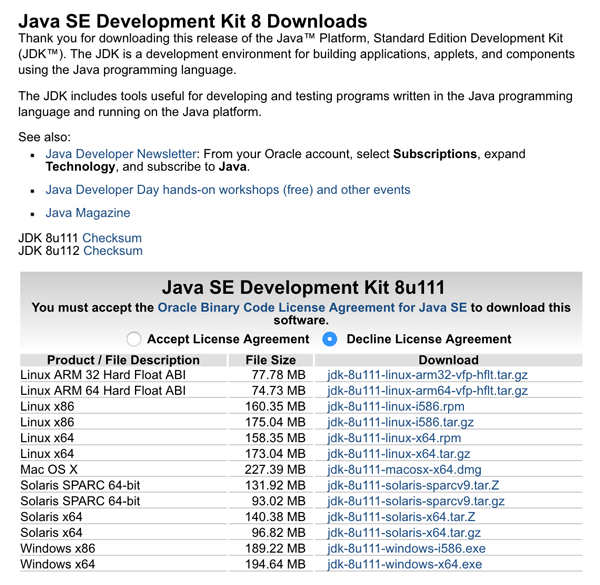Download Java 10 Mac
8/10 (16 votes) - Download Java JDK Mac Free. Java JDK 8 SE is the pack of tools necessary to develop applications in one of the most widespread software development languages around the world. Java has become one of the most popular development languages in the world, mainly due to its. Java Runtime Environment works smoothly, whether you are using a laptop or a scientific supercomputer, and supports such major platforms as Windows, Linux and Mac. Visit Java Runtime Environment site and Download Java Runtime Environment Latest Version! Java for Mac OS X 10.5 Update 10 delivers improved compatibility, security, and reliability by updating J2SE 5.0 to 1.5.030, and updating Java SE 6 to 1.6.026 for 64-bit capable Intel-based Macs. Since OS X 10.7 Java is not (pre-)installed anymore, let’s fix that. As I’m writing this, Java 11.0.4 is the latest version and AdoptOpenJDK is one of the best places to find Prebuilt OpenJDK Binaries. Download Java for OS X directly from Oracle. Get the latest version If an app or webpage you want to use asks you to install Java software, you can download the current version of Java for OS X directly from Oracle's website.
RSS Feed RSS Feed (free software only)91 applications totalLast updated: Nov 27th 2020, 14:55 GMT
DbVisualizer 11.0.6
Comprehensive and all-inclusive database administration utility tool designed to help DBAs, develo..
Annotation File Utilities 3.9.14
Open source and free Java utility that provides support for reading and writing annotation files (..
YourKit Java Profiler 2020.9 Build 405
A lightweight yet powerful performance and memory Java profiler that makes it easy for you to anal..
JD-GUI 1.6.6
A Java decompiler designed for multiple platforms which enables you to analyze the source code of ..
DbWrench 4.2.5
An user-oriented and easy-to-use Java application that enables you to quickly and effortlessly mak..
BlueJ 4.1.2
Interactive and open source Java development environment
Atmosphere 2.4.30
Free and open source Java/Javascript framework that helps developers to build their own portable c..
Kundera 3.8
Simplify and improve your workflow with cross-platform NoSQL datastores with the help of open sour..
RESTClient 3.6.2
Macbook pro efi firmware update. Helps you test RESTful web services
DAOMedge 9.2.2
A powerful Data Access Object suite that includes a code generator for generating Java Value Objec..
Blitz4j 1.36.2
Open source and free Java logging framework designed to help developers make use of fast asynchron..
Apache Camel 2.18.2
Open source integration framework with powerful Bean Integration
junit-quickcheck 0.4 / 0.5 Beta 1
A free and open-source java library designed to supply JUnit theories with various random values f..
Rectangle

The Unarchiver
Microsoft Remote Desktop
Apple Xcode
Keysmith
Mimestream
VLC Media Player
macOS Big Sur
Big Sur Cache Cleaner
AppCleaner
Alfred
Amphetamine
Hidden Bar
Aerial
Keka
- macOS Big Sur
- Big Sur Cache Cleaner
- AppCleaner
- Alfred
- Amphetamine
- Hidden Bar
- Aerial
- Keka
- Rectangle
- The Unarchiver
- Microsoft Remote Desktop
- Apple Xcode
- Keysmith
- Mimestream
- VLC Media Player
Apache Jackrabbit 2.16.3
Fully conforming content repository for Java technology API
ScalaCheck 1.12.5
A powerful tool for automatic unit testing
ASM 5.0.4
A free Java bytecode manipulation and analysis framework
ojAlgo 38.1
Open Source Java Algorithms for Mathematics, Linear Algebra and Optimization
Clojure 1.8.0
A dynamic programming language for the Java Virtual Machine
Moqui Framework 1.6.1
Helps you create web-based and distributed enterprise applications
Download Java Runtime Environment 10 For Mac
H2 Database Engine 1.3.176 / 1.4.188 Beta
Structured Query Language database engine written in Java that has a browser based console applica..
Lombok 1.16.6
Development tool that adds handlers to Java
JCommander 1.48
Small Java framework to easily parse command line parameters
JGoodies Looks 2.8.0
High-fidelity and multi-platform Swing look and feels
JGoodies Common 1.9.0
Java library that provides convenience code for JGoodies apps and libraries
JGoodies Binding 2.14.0
Free Swing data binding framework
MZmine 2.14.2
A Java written framework for differential analysis designed from the ground up to help its users t..
JGraphT 1.0.0
Free and open source Java graph library
yGuard 2.5.4
Java bytecode obfuscator and shrinker
Kieker 1.11
Analyze and monitor distributed software systems, detect performance problems and log the behavior..
MicroEmulator 2.0.4
Test your J2ME MIDlets via this simple yet powerful Java 2 Micro Edition (J2ME) emulator that can ..
This page tells you how to download and install Java 8 and Eclipse on Mac OS X, and how to configure Eclipse.
Installing Java 8
Go to the Oracle website. You'll see something like this:
Scroll down until you see a heading beginning 'Java SE 8u65/8u66.' On the right, you'll see a Download button under the JDK header. Click it. The next screen will look like this:
Click the radio button next to 'Accept License Agreement' and then click on jdk-8u65-macosx-x64.dmg. You'll be asked whether to save the file that is going to be downloaded; click on Save File.
Open your Downloads folder, and double-click on jdk-8u65-macosx-x64.dmg. You'll see this window:
Double-click on the package icon, and follow the instructions to install. When the installation has completed, click on Done. At this point, you may close up the window and drag jdk-8u65-macosx-x64.dmg to the Trash.
Installing Eclipse
If you already have Eclipse installed on your Mac, you need to get rid of it. To do so, first quit Eclipse if you're currently running it. Then, go to your workspace folder (probably in Documents/workspace) and save anything there that you want to keep, because you're about to get rid of this folder. Next, drag the workspace folder to the Trash.
Go to your Applications folder. One way to get there is, from the Finder, type command-shift-A. You'll a folder named eclipse in there; drag the eclipse folder to the Trash. If you have an Eclipse icon in your dock, remove it from the dock.
Now you're ready to download and install the newest version of Eclipse. Go to this website. You'll see a window like this:
Scroll down until you see 'Eclipse IDE for Java Developers' and click where it says 64 bit under Mac OS X.
You will see this window:
Click on the yellow download button. If asked, click on 'Open with Archive Utility (default)' and then click OK. The download might take a few minutes. You should not feel compelled to donate.
After the download completes, folders should automatically expand. If they don't, double-click on the .tar file. When that's done, you should see a folder named eclipse in your Downloads folder. When you open your Downloads folder, if you see Applications under the Favorites on the left side of the window, you should drag the eclipse folder into Applications. If you don't see Applications, then open a new window for Applications (from the Finder, command-shift-A), and drag the eclipse folder into Applications.
Open your Applications folder, and then open the eclipse folder. You'll see an item named Eclipse; if you like, drag its icon into the dock so that you'll be able to launch Eclipse easily.
Launch Eclipse. If you're asked whether you want to open it, of course you do; click Open. You'll see a window like this:
It will have your user name rather than mine (scot). Select where you want your workspace to be; I recommend the default of your Documents folder. Click the checkbox for using this location as the default, and then click OK.
You'll see a window like this:
Click on the Workbench arrow in the upper right that I've circled. You shouldn't see this screen again, even if you quit Eclipse and relaunch it.
You'll get an empty workbench like this:
We won't be using the 'Task List' and 'Connect Mylyn' windows. Click the 'x' on each to close it. Press the mouse on the Window menu item, then choose 'Perspective', and finally choose 'Save Perspective as..'. Enter 'cs10' for the name of this perspective and press return. Your workbench will now look like this:
You have now installed Eclipse!
Configuring Eclipse

You don't have to configure Eclipse the way I do, but you'll probably avoid some confusion if you do. Here's how.
Download Java Virtual Machine Windows 10
In the Eclipse menu bar, click on the Eclipse menu and then on 'Preferences..'. You'll see a window with two panes. On the left pane is a list of types of things you can configure.
Click on the triangle to the left of General. Then click on the triangle to the left of Appearance. Then click on 'Colors and Fonts.' You should see a window like this:
In the window in the middle, click on the triangle next to Java. Then double-click on 'Java Editor Text Font':
You'll see this window:
On the right, where you can select the size, click 12. Then close this window by clicking on the window's close button.
Close up the General preferences by clicking on the triangle to the left of General. Click the triangle next to Java and then click the triangle next to 'Code Style.' Then click Formatter. Here's what you should see:
Click the button that says 'New..'. You'll see a window such as this one:
You can type in any profile name you like. I used 'CS 10':
Click OK.
You should see a window like this:
Change the tab size to 2:
You'll see that the indentation size automatically changes as well.
Click on 'Blank Lines,' and after 'Between import groups' and 'Before declarations of the same kind,' change the values 1 to 0:
Click on 'Control Statements,' and check the first four boxes as I've done here:
Click OK.
Now click on triangles to close up Java. Click on the triangle next to Run/Debug, and then click on Console:
Click on the green color sample next to 'Standard In text color.' You'll get a color picker:
Slide the slider on the right down, so that you get a dark green. (You're at Dartmouth. What other color could you possibly want?)
Close the color picker window by clicking its close button, and click OK again to close the Preferences window.
And you're done!
